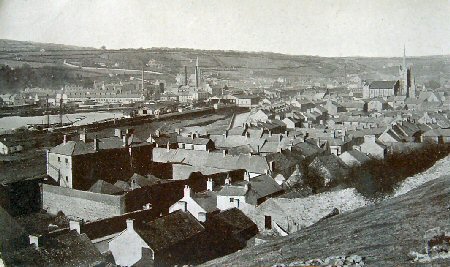Among the notable clans who hailed from this area are the Jennings, McParland, Carr, Carroll, Duffy, Fox, Gorman, Hughes, Feenan, Keenan, Kelly, Coulter, Bannon, Lambe, McElroy, McCourt, McGrath, McGivern, McGuinness, McKeown, McKevitt, Mathers, Murtagh, Price, Traynor and Tumilty families.
Of the first, the most well-known now is the highly-successful soccer goalkeeper of the recent past, Pat Jennings. But even more illustrious ancestors went before.
Sir Patrick Alfred Jennings emigrated from Castle Street to Victoria in 1852, was a businessman in Victoria (St Arnaud near Bendigo), pasturalist in NSW (Deniliquin district, Gunnedah district and Codobilin district) and Queensland (Darling Downs); and politician, chiefly in NSW where he was briefly Premier in 1886-7. He was knighted by Queen
Another more recent migrant Hugh Jennings of Chapel Street settled in Minneapolis (where Kevin Keenan now is!) and became Alderman of that great city. He was also President of the Federation of Labour and also President of the Stonecutters Union, and a court official. The Journal said of him,
‘Hugh left for the United States at a time when conditions were vastly different from today. He applied himself with grit and determination and through his tenacity and enthusiasm reached the pinnacle of success. The Newry emigrant won the esteem and confidence of people of every nationality who rewarded him by appointing him their first citizen.
In the early days he helped construct schools and other public buildings here. He embarked on a 17 day coach ride across the prairie of South Dakota and the Rockies to the Columbia River, where he was foreman at the construction of a 22 arch stone viaduct across the Mississippi River (incidentally dwarfing our own 18 Arches!).
Hugh has resided these past forty years at 818 Queen’s Avenue in Minneapolis. His brother Patrick has beaten that record however. He lived in Chapel Street for eighty three years. Hugh returned home to pay his respects when Patrick’s wife died.’
The Jennings family tree shows they have been resident in Newry since 1800 when Michael was born to one Francis Jennings. He had a brother called Patrick who emigrated to England, and two other sons Hugh and James. Many of the men-folk were stone masons (a favoured occupation in these parts up to a half century ago). It was the Moor Hill quarries that attracted them first to Chapel Street from Saval. Before the coming of bitumen the streets of our Frontier Town were paved with granite sets (those you still can see in The Mall). Newry Granite was famous worldwide and exports to foreign lands gave much needed employment. Ships would sail from Carlingford Lough up the Clanrye River to Quay Street (before the building of the Ship Canal and Albert Basin). Patrick Jennings was employed as a shipping clerk before becoming a stevedore, responsible for the loading of the ships. Patrick had a son of the same name who worked in a spinning mill as a doffer. A curious coincidence this, for our current Pat Jennings (best keeper in the world) recalls that he was employed in a local mill as a ‘bobbin-boy’. It was Pat’s cousin Seamus Jennings, who spent some years in Canada with his wife Maura Heaney (sister of Michael of the Newry Golf Club) who drew up the family tree. This couple returned home and for a while had the shop in Chapel Street that had previously been run by the late Councillor Niall McAteer.
Our own Pat is the son of John and Sadie (Cunningham) of Whitecross. Her father was a midfielder on a previous Armagh team, and it’s said that from him Pat inherited those huge hands and his fielding ability. The Jennings family lived next door to his aunt, Molly McAteer who ran the shop. Pat said,
‘My father was never out of work when we were growing up so we didn’t go hungry. We weren’t exactly well-off either. That’s why, when I was young, I did all sorts of odd jobs, selling bundles of firewood, at one penny a time; chopping up logs and selling them too. Also we would spend 12 hours a day picking blackberries or rose-hips and selling them to Gavigans (another Journal story!).
I also helped on a milk round. Peter Woods, my milkman employer was less than impressed. One day I jumped off the milk cart and my trousers caught on a crate. Down it came with all its full bottles of milk! I can still see Peter’s look of anguish, and hear his tirade of expletives!
Also I was delivery boy for a grocer in the town centre (‘Gallagher’s ‘balls-of-flour’?? Ed). All the goods were loaded on a carrier on the front of the bicycle. So heavy were the goods that I more often than not pushed, rather than rode it to the delivery homes.
Pat’s great regret from his fabulous career is that he never got to play for an All-Ireland team at international level. ‘If they can do it for Rugby, why not for soccer,’ he ruefully reflected.
Referring to sectarian abuse (that, for example, recently caused Neil Lennon to abandon his dreams of representing Northern Ireland) Pat stated,
‘The supporters are more concerned with religious and political differences than the players. Some gave me a hard time. I was appalled at the remarks hurled at me. It’s ordeal enough for a teenager to turn out for his country, without that! I found it a nasty shock that my home crowd, or a section of it, was not exactly rooting for me. But I was finally accepted. Maybe the die-hards despaired of getting rid of me,’ he concluded. ‘Maybe’, I thought, ‘they knew no one could replace you!’
‘I’ve been one of the lucky ones. That’s why I try to put something back into the game. Soccer is the greatest game for me. I only wish I was starting out again.’
Derrybeg …
